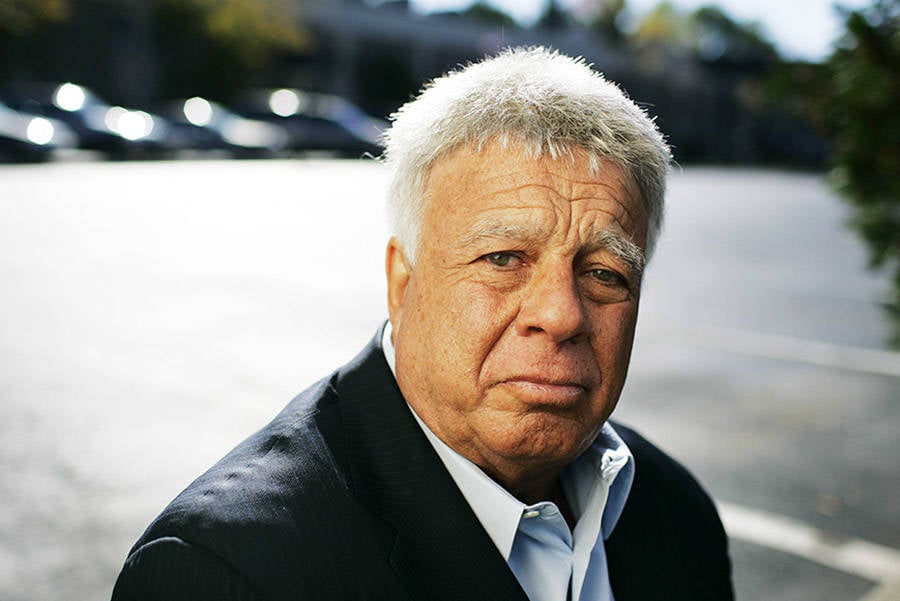The Harlem kingpin who inspired "American Gangster," Frank Lucas began importing and distributing "Blue Magic" heroin in the late 1960s — and made a fortune.
It’s no wonder why Ridley Scott made American Gangster, a movie based on the life of Harlem heroin kingpin Frank “Superfly” Lucas. The details of his ascent to the upper echelon of the 1970s drug trade are as wildly cinematic as they are likely exaggerated. What better medium to tell such a trumped-up tale than a Hollywood blockbuster?
Though the 2007 movie is supposedly “based on a true story” — starring Denzel Washington as Frank Lucas — many in Lucas’s orbit have said that the film is largely fabricated. But piecing together the truth of his life and his many misdeeds is a daunting task.

YouTubeDuring the late 1960s and early 1970s, Frank Lucas built a heroin empire in Harlem.
The most well-known profile of the man, Mark Jacobson’s “The Return of Superfly” (which the film is largely based on), relies mostly on Frank Lucas’s own firsthand account that is full of boasts and braggadocio from a notorious “braggart, trickster, and fibber.”
If you’re unfamiliar with Lucas or with the film, here are some of the wildest details about his life (have a few grains of salt handy).
Who Was Frank Lucas?
Born on September 9, 1930, in La Grange, North Carolina, Frank Lucas had a rough start to life. He grew up poor and spent a lot of time looking after his siblings. And living in the Jim Crow South took a toll on him.
According to Lucas, he was first inspired to enter a life of crime after he witnessed Ku Klux Klan members murder his 12-year-old cousin Obadiah when he was just six years old. The Klan claimed that Obadiah had engaged in some “reckless eyeballing” of a white woman, so they fatally shot him.
Lucas reportedly fled to New York in 1946 — after beating up his former boss at a pipe company and robbing him of $400. And he quickly realized there was much more money to be made in the Big Apple.
From robbing local bars at gunpoint to swiping diamonds from jewelry stores, he slowly became bolder and bolder with his crimes. He eventually caught the eye of drug trafficker Ellsworth “Bumpy” Johnson — who acted as a mentor of sorts to Lucas and taught him everything he knew.
While Lucas took Johnson’s teachings to the next level with his crime organization, there was a sad and ironic twist to Lucas’s desire to get back at the KKK members who murdered his cousin. Thanks to his deadly brand of imported heroin, known as “Blue Magic,” he ended up wreaking havoc in Harlem — one of New York City’s most iconic Black neighborhoods.
“Frank Lucas has probably destroyed more Black lives than the KKK could ever dream of,” prosecutor Richie Roberts told The New York Times in 2007. (Roberts was later portrayed by Russell Crowe in the movie.)

David Howells/Corbis/Getty ImagesRichie Roberts, who is portrayed by actor Russell Crowe in the film American Gangster.
How Frank Lucas supposedly got his hands on this “Blue Magic” is perhaps the wildest detail of all: He allegedly smuggled the 98-percent-pure heroin into the United States by using the coffins of dead soldiers — coming home from Vietnam. Jacobson calls it his “most culturally pungent” claim to fame:
“Of all the dreadful iconography of Vietnam — the napalmed girl running down the road, Calley at My Lai, etc., etc. — dope in the body bag, death begetting death, most hideously conveys ‘Nam’s spreading pestilence. The metaphor is almost too rich.”
To his credit, Lucas said that he didn’t put the smack next to the bodies or inside the bodies as some legends have suggested. (“No way I’m touching a dead anything,” he told Jacobson. “Bet your life on that.”) He instead said that he had a carpenter buddy flown in to make “28 copies” of government coffins rigged up with false bottoms.
With help from former U.S. Army sergeant Leslie “Ike” Atkinson, who just so happened to be married to one of his cousins, Lucas claimed to have smuggled more than $50 million worth of heroin into the U.S. He said $100,000 of that was on a plane carrying Henry Kissinger, and that he at one point dressed up as a lieutenant colonel to aide in the operation. (“You should have seen me — I could really salute.”)
If this so-called “Cadaver Connection” story sounds like an impossible operation, it just might have been. “It is a total lie that’s fueled by Frank Lucas for personal gain,” Atkinson told the Toronto Star in 2008. “I never had anything to do with transporting heroin in coffins or cadavers.” Though Atkinson fessed up to smuggling, he said it was inside furniture, and that Lucas wasn’t involved with making the connection.
From Low-Ranking Drug Dealer To “American Gangster”

Wikimedia Commons/YouTubeFrank Lucas’s federal mugshot and Denzel Washington as Lucas in American Gangster.
How Frank Lucas managed to get his hands on “Blue Magic” might’ve been a fabrication, but there’s no denying that it made him a rich man. “I wanted to be rich,” he told Jacobson. “I wanted to be Donald Trump rich, and so help me God, I made it.” He claimed to be making $1 million per day at one point, but that, too, was later discovered to be an exaggeration.
In any case, he was still determined to show off his newly acquired wealth. So in 1971, he decided to wear a $100,000 full-length chinchilla coat — at a Muhammad Ali boxing match. But as he later wrote, this was a “massive mistake.” Apparently, Lucas’s coat caught the eye of law enforcement — who were surprised that he had better seats than Diana Ross and Frank Sinatra. As Lucas put it: “I left that fight a marked man.”
So regardless of how much money he was actually making, Lucas didn’t get to enjoy the fruits of his labor for very long. After supposedly hobnobbing with some of New York’s wealthiest and most famous folks in the early 1970s, the famously fur-clad Frank Lucas was arrested in 1975, thanks in part to Roberts’ efforts (and some Mafia snitching).
The drug lord’s assets were seized, including $584,683 in cash, and he was sentenced to 70 years in prison. Lucas later bristled at such a low count of cash money, and accused the DEA of stealing from him, according to Superfly: The True Untold Story of Frank Lucas, American Gangster:
“‘Five hundred and eighty-four thousand. What’s that?’ Superfly boasted. ‘In Las Vegas I lost 500 Gs in half an hour playing baccarat with a green haired whore.’ Later, Superfly would tell a television interviewer that the figure was actually $20 million. With time, the story has kept getting longer like Pinocchio’s nose.”
Lucas likely would’ve been in prison for the rest of his life — if he didn’t become a government informant, enter the witness protection program, and ultimately help the DEA nab more than 100 drug-related convictions. One relatively minor setback aside — a seven-year sentence for an attempted drug deal in his post-informant life — he went on parole in 1991.
Overall, Lucas managed to get through everything relatively unscathed and reportedly enriched. According to the New York Post, Lucas received “$300,000 from Universal Pictures and another $500,000 from the studio and [Denzel] Washington to buy a house and a new car.”
But at the end of the day, beyond the ravages of his famous “Blue Magic,” Lucas was an admitted killer (“I killed the baddest motherf–ker. Not just in Harlem but in the world.”) and an admitted liar, on a grand scale. Robin Hood, he was not.
In some of his last interviews, Frank Lucas walked back a bit of the braggadocio, admitting, for instance, that he only had one false-bottom coffin made.
And for what it’s worth, Lucas also admitted that only “20 percent” of American Gangster is true, but the guys that busted him said that’s also an exaggeration. DEA agent Joseph Sullivan, who raided Lucas’s home back in 1975, said it’s closer to the single digits.
“His name is Frank Lucas and he was a drug dealer — that’s where the truth in this movie ends.”
The Death Of Frank Lucas

David Howells/Corbis/Getty ImagesFrank Lucas in his later years. The former gangster died of natural causes in 2019.
Unlike other famous gangsters, Frank Lucas didn’t go out in a blaze of glory. He died in 2019 at the age of 88 in New Jersey. His nephew, who confirmed his death to the press, said that he died of natural causes.
By the time Lucas died, he had become pretty good friends with Richie Roberts — the man who helped bust him. And ironically enough, Roberts eventually ended up getting in some trouble with the law himself — pleading guilty to tax crimes in 2017.
“I am not one to condemn anyone for anything that they do,” Roberts said after Frank Lucas’s death. “Everyone gets a second a chance in my world. Frank did the right thing [by cooperating].”
“Did he cause a lot of pain and hardship? Yeah. But that is all business. On a personal level, he was very charismatic. He could be very likable, but I wouldn’t want to, well, I was on the wrong end of him. There was a contract on me at one time.”
Roberts had the chance to talk to Lucas just a few weeks before he died and was able to tell him goodbye. Although he was aware that the former drug kingpin was in poor health, he still found it hard to believe that Frank Lucas was really gone.
He said, “You expected him to live forever.”
After learning about Frank Lucas and the real story of “American Gangster,” take a look at the history of 1970s Harlem in pictures. Then, explore the rest of the city in 41 horrifying photos of life in 1970s New York.





